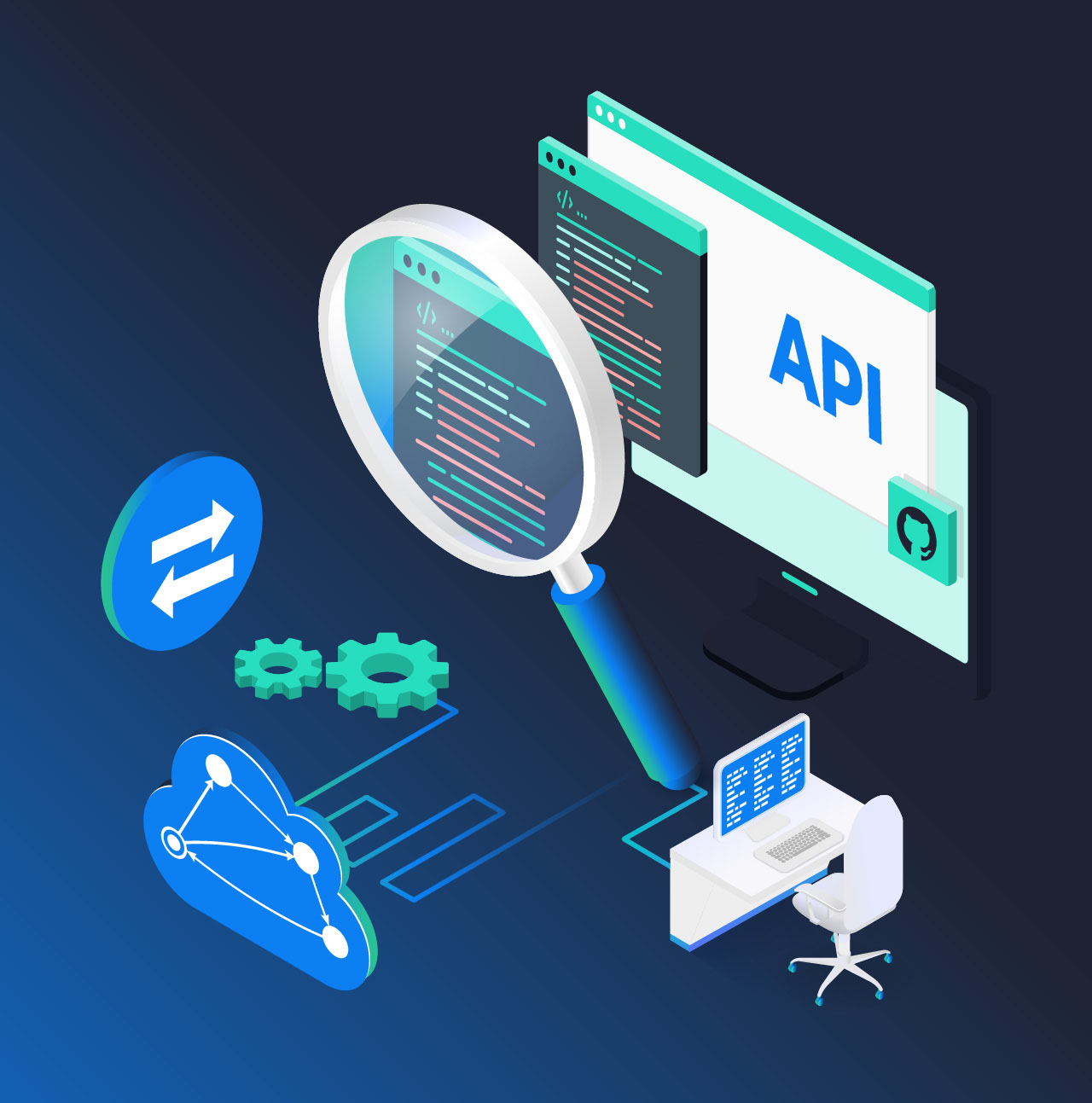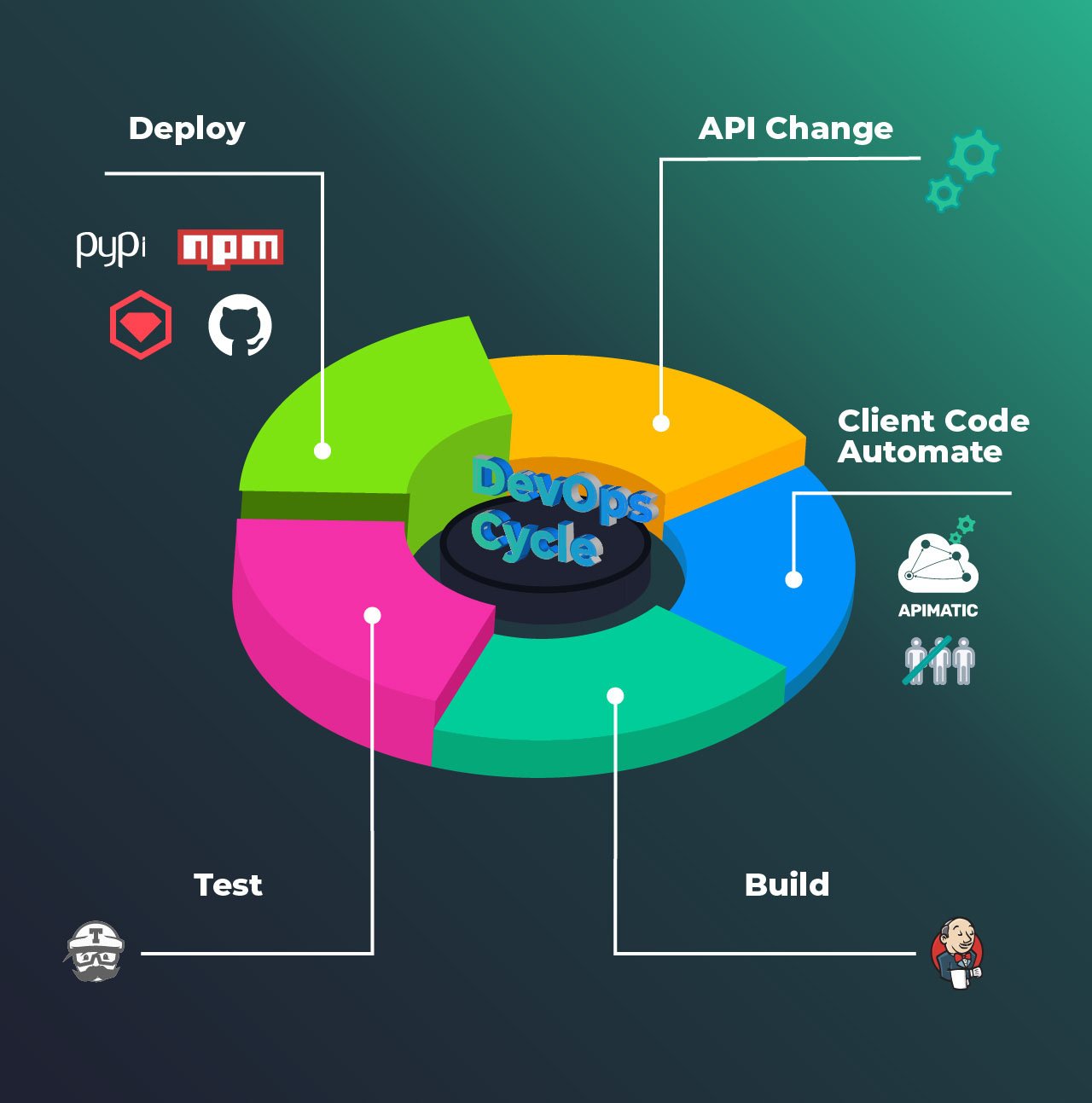In the API world, the vast majority of external services will be composed of numerous microservices internally. While trying to hide this complexity from API consumers, we must deal with combining the various microservices’ specifications into a single unified interface.
In this how-to, I will illustrate how easy it is to automatically merge API specification documents of each microservice to create one composite API definition which will allow auto-generation of developer experience components like API portal/documentation, SDKs, etc. I will also mention some approaches available to automatically filter out endpoints and their related data from the documents before they are merged.
Why Would Businesses Need to Merge Their APIs?
Businesses use the microservices architectural pattern to split their core services into smaller, independent units. This increases efficiency and reduces development and maintenance costs. However, from a consumer point of view, these microservices semantically represent a single service. Providing unified API documentation with a single SDK per language and only one machine-readable API specification will significantly reduce the time and effort it takes for them to integrate with their service as compared to integrating with multiple APIs.
Therefore, how a service is structured internally in a business should be abstracted away from the end-users to ease API integration and consequently increase API adoption rates:
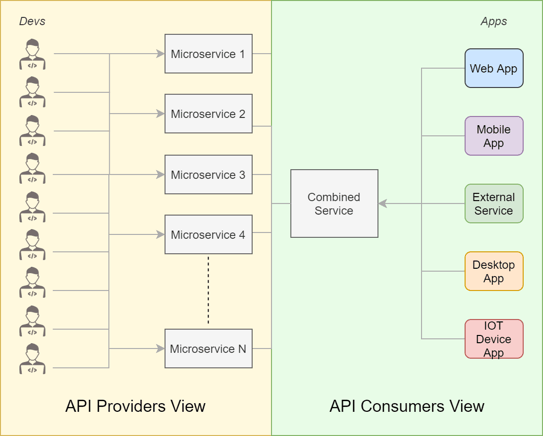
Merging API Specifications of Microservices Using APIMatic
APIMatic lets you automatically merge ‘N’ specifications into a single specification. The input specifications can be any combination of specifications supported by APIMatic such as RAML, OpenAPI, Postman Collections, etc. You can then use the merged API definition to generate an API developer portal bundled with client SDKs, language-specific documentation, live code samples, and more.
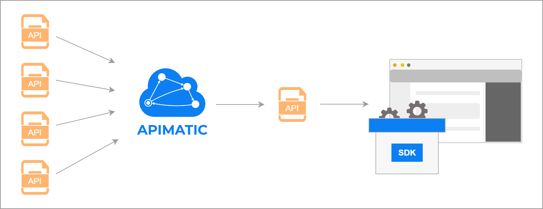
Characteristics of Specification Documents of the Same Business
Before diving headfirst into merging, here are some high-level characteristics that specification documents of microservices (e.g. OpenAPI) belonging to the same service share:
Different Base Server URLs
Since each microservice targets a different business capability or resource, their base server URLs will likely share some initial common segments but can be overall unique. Upon merge, therefore, this server configuration should remain intact.
Unique Endpoints
The endpoints/operations of each microservice will likely work with different resources and so are expected to be unique. Merging them would most probably just be a simple concatenation.
Overlapping Schemas
Because the services belong to the same business, there can be a large number of overlapping schema definitions in the documents. Upon merge, these definitions should not be duplicated.
Equal or Varying Authentication Schemes
The authentication schemes used by the services may or may not vary, therefore, all schemes present in the documents should be preserved upon merge.
Step-by-Step Walkthrough of Merging Two API Specifications Using APIMatic
To illustrate merging in a better way, I provide an example of a hypothetical company “MusicPlay” that offers a music application to its users where they can browse and listen to tracks of their choice and even create personalized playlists. Their database holds a large number of artists, albums, and tracks that any user can listen from.
MusicPlay internally has two microservices: a User API service that solely manages user accounts and their playlists, and a Library API service that sits on top of the database and helps users query for artists, albums, or tracks as well as lets artists add/remove albums and tracks, etc.
I will now take you through the steps to merge the two API definitions User API and Library API using APIMatic in order to create unified API documentation and SDKs. The OpenAPI specification documents I use for this purpose can be found here and here respectively.
Step 1: Create a Local Directory Structure for Specifications
Merging requires me to place the specifications in an appropriate directory structure which I create as discussed below. If you want, you can check out what the final structure looks like here.
Create a Root Directory
In my local file system, I create a root directory named MusicPlay Merge Example. This directory will hold the specification documents as well as the configuration file required to enable merging.
/MusicPlay Merge ExampleCreate a Subdirectory for User API
Each API specification that needs to be added should have its own dedicated subdirectory inside the root directory. Accordingly, I create a subdirectory named User API in the directory MusicPlay Merge Example and place the User API’s OpenAPI specification file in it as shown below:
/MusicPlay Merge Example
/User API
MusicPlay User API.yamlCreate a Subdirectory for Library API
Similar to the previous step, I then create another subdirectory in the root directory named Library API in which I place the OpenAPI specification file for the Library API/microservice:
/MusicPlay Merge Example
/Library API
MusicPlay Library API.yaml
/User API
MusicPlay User API.yamlStep 2: Add Configuration Metadata Files
Metadata File to Enable Merging
I then create an empty JSON file in the root directory and name it APIMATIC-META.json. The name is important as it ensures that the file is auto-detected as the APIMatic’s metadata file during import:
/MusicPlay Merge Example
/Library API
MusicPlay Library API.yaml
/User API
MusicPlay User API.yaml
APIMATIC-META.jsonI add the following configurations in the metadata JSON file:
{
"MergeConfiguration": {
"MergeApis": true,
"MergeOrderOfDirectories": ["User API", "Library API"],
"MergedApiName": "MusicPlay API",
"MergeSettings": {
"ConflictStrategy": "KeepLeft",
"DescriptionConflictStrategy": "KeepBoth"
}
}
}Some details about the configurations and their effect on the two APIs being merged are given below:
MergeConfigurationdefines the overall merging process for your API specifications.- Setting
MergeApistotrueenables merging. Without this, the first API description detected in the directory will be picked up and any other API descriptions will be ignored. MergeOrderOfDirectorieswill control in which order the two API descriptions will be merged. The order matters as the items from the first (left) API are picked up first and the items from the second (right) API are added after those of the first. The order also plays an important role when resolving merge conflicts as will be explained under theConflictStrategymerge setting. For the current example, although alphabeticallyLibrary APIthe first API directory andUser APIthe second API directory, User API will be treated as the first API because of the order specified inMergeOrderOfDirectories.MergedApiNamehelps assign the name “MusicPlay API” to the merged API definition. If this was not provided, then by default the name of either the left API or right API would have been picked up depending on the order and conflict strategy used for merging the two APIs.MergeSettingscontrols the process that merges User API and Library API definitions.KeepLeftconflict strategy in theConflictStrategymerge setting ensures that if a conflict occurs, information of the left User API will remain intact while that of the right Library API will be updated or discarded as applicable.DescriptionConflictStrategyis an alternate conflict strategy for descriptions. ItsKeepBothvalue ensures that if two conflicting descriptions are found in the User API and Library API, then both will be preserved.
Metadata File to Enable Endpoint Filter for Subdirectory User API
The User API contains an operation getAllUsers which is tagged as internal in the OpenAPI file as it is not meant for public use. Therefore, the merged API definition should not contain this endpoint. To filter it out, I add a configuration metadata JSON file APIMATIC-META.json in the subdirectory User API as shown below:
/MusicPlay Merge Example
/Library API
MusicPlay Library API.yaml
/User API
MusicPlay User API.yaml
APIMATIC-META.json
APIMATIC-META.jsonI then add the following to the metadata file to enable filtering:
{
"RemoveEndpointsWithTags": ["internal"]
}RemoveEndpointsWithTags will ensure that during merging, the endpoints that contain the tag internal and their related data will be removed.
Step 3: Zip the Directory
The contents of the directory MusicPlay Merge Example are now ready for merging:
/MusicPlay Merge Example
/Library API
MusicPlay Library API.yaml
/User API
MusicPlay User API.yaml
APIMATIC-META.json
APIMATIC-META.jsonI zip them into a final MusicPlay.zip file. Take note that it is important to ZIP the contents of the root directory and not include the root directory itself.
Step 4: Upload ZIP File into APIMatic
Next, I login into APIMatic.
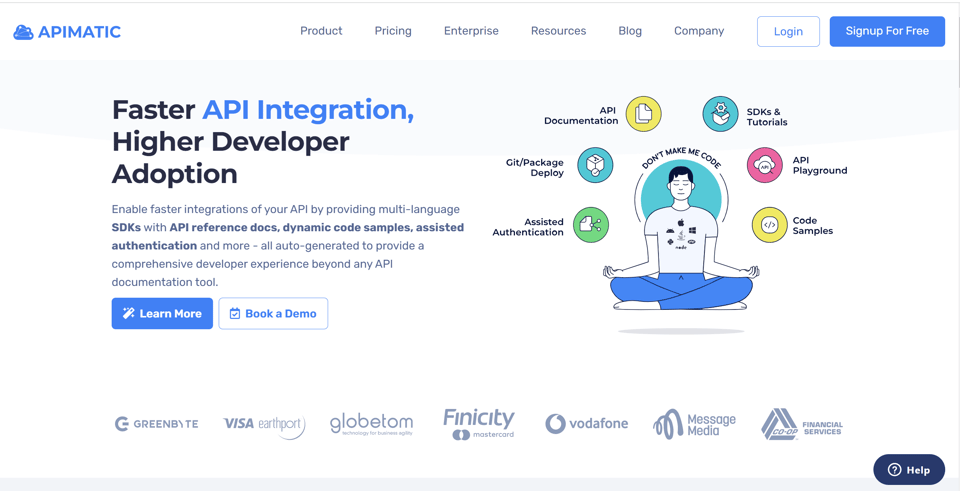
Logging into APIMatic will open the APIMatic Dashboard for me. I click on the Import API option as shown below:

Here, I browse and upload my MusicPlay.zip file and then click on Import:
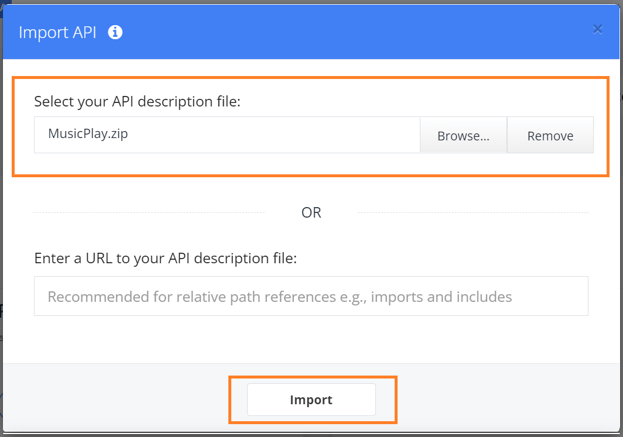
During import, the ZIP file I uploaded undergoes merging behind the scenes. As part of this, the individual API specifications as well as the merged API specification are validated. The merging completes successfully and I’m shown some informational validation messages linked to the individual as well as merged API definitions: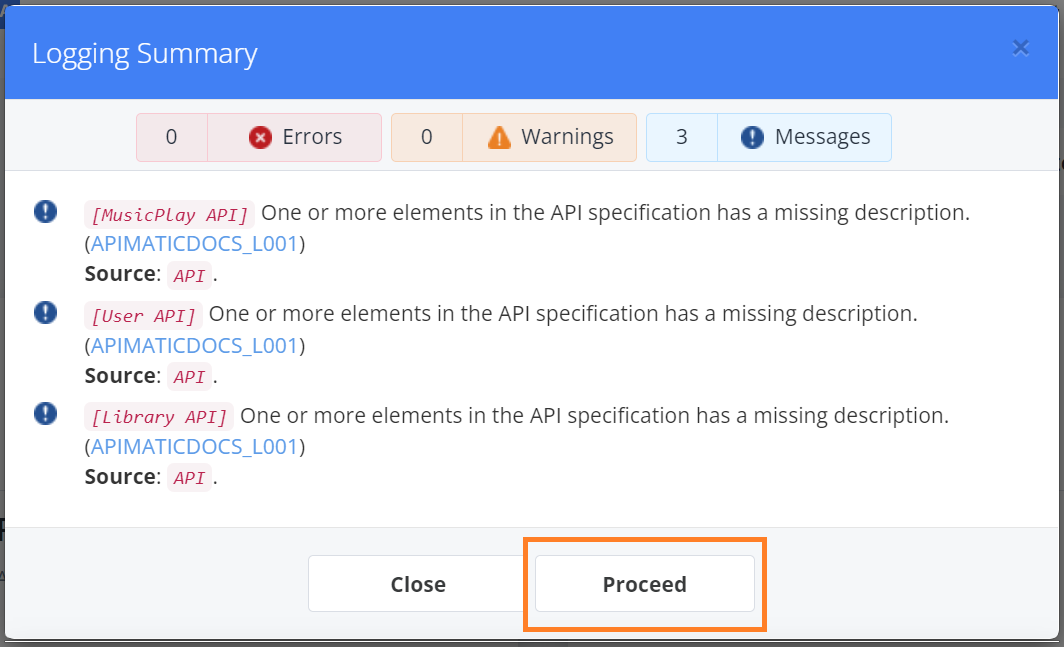
Since the validation messages are not errors/warnings, the import was successful. So, I go ahead and click on Proceed. The merged API definition will then become visible in my Dashboard as shown below: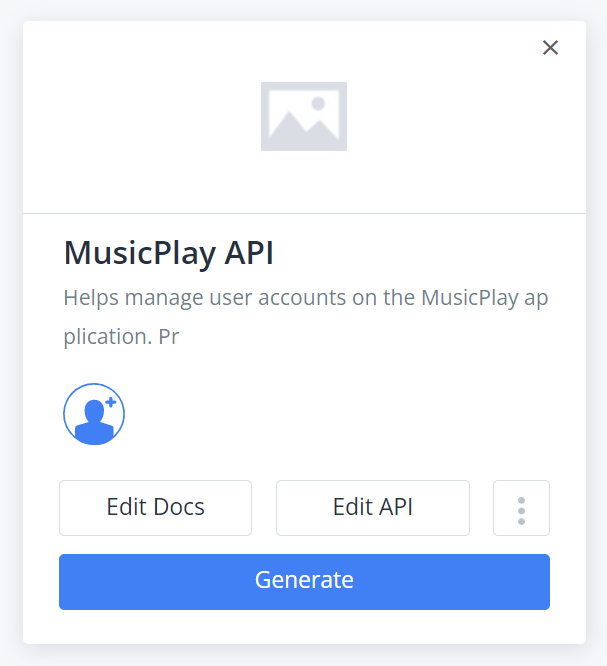
Notice how it has the name MusicPlay API which I provided earlier in the configuration file.
Step 5: Preview Developer Experience Portal
From the Dashboard entity of the merged API definition, I click on the Generate button and then click on Preview API Portal: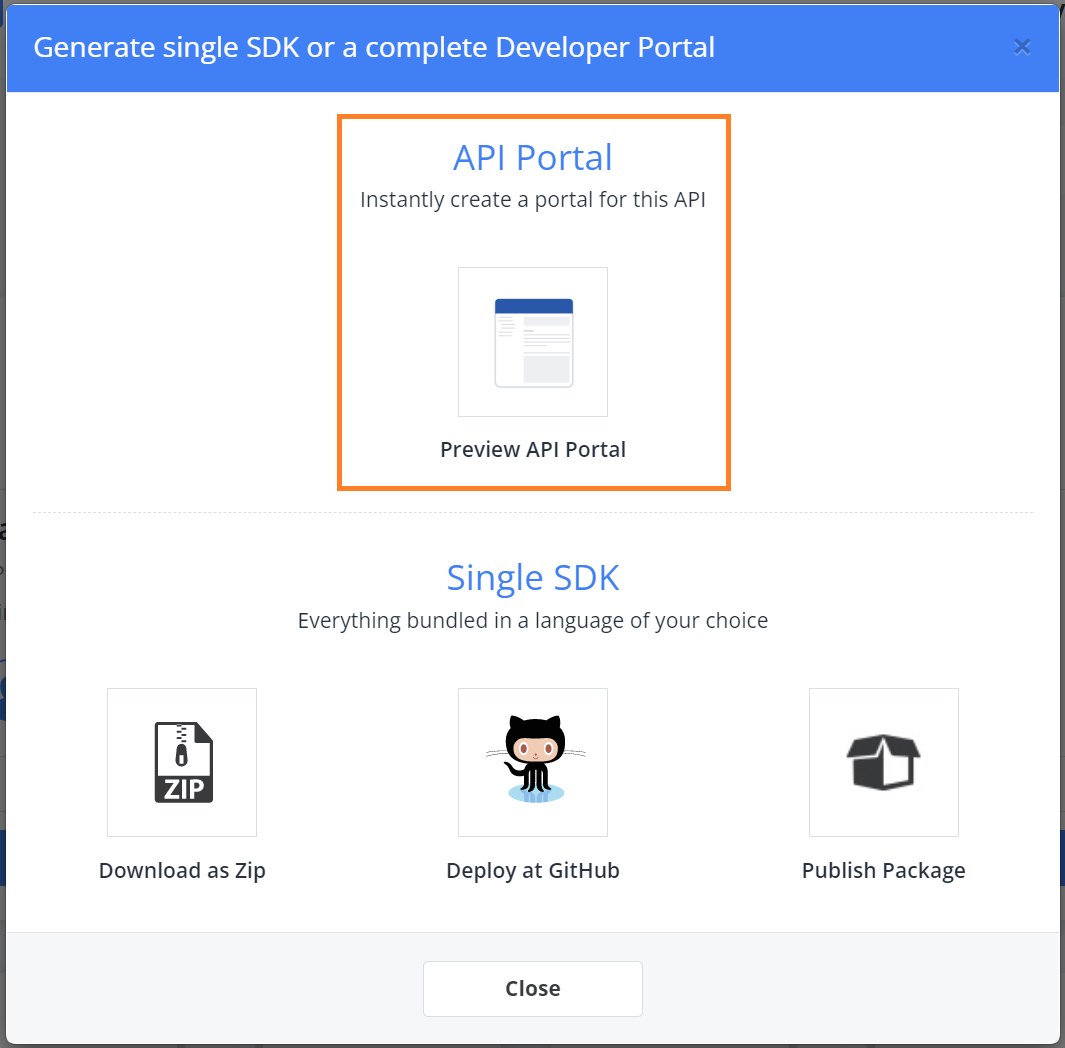
I will be taken to a preview mode of the unified API documentation. Here, I can choose to open up the HTTP documentation or even any language-specific documentation. I can also generate SDKs or publish and customize the portal to suit my needs better.
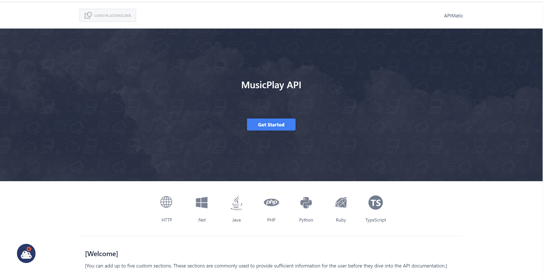
Analysis of the Merged Documentation
To illustrate what the merged output for my MusicPlay APIs looks like, I decided to compare a few components below. For each component, I show what the input data from the APIs was and what the same information looks like in the autogenerated HTTP documentation after merging.
Basic API Information
MusicPlay User API basic API information:
openapi: "3.0.0"
info:
version: 1.0.0
title: MusicPlay User API
description: Helps manage user accounts on the MusicPlay application.
servers:
- url: https://musicplay.io/api/v1/users
security:
- oauth2: []
MusicPlay Library API basic API information:
openapi: "3.0.0"
info:
version: 1.0.0
title: MusicPlay Library API
description: Provides data related to the MusicPlay library including artists, tracks, etc.
servers:
- url: https://musicplay.io/api/v1/library
security:
- oauth2: []
Merged output: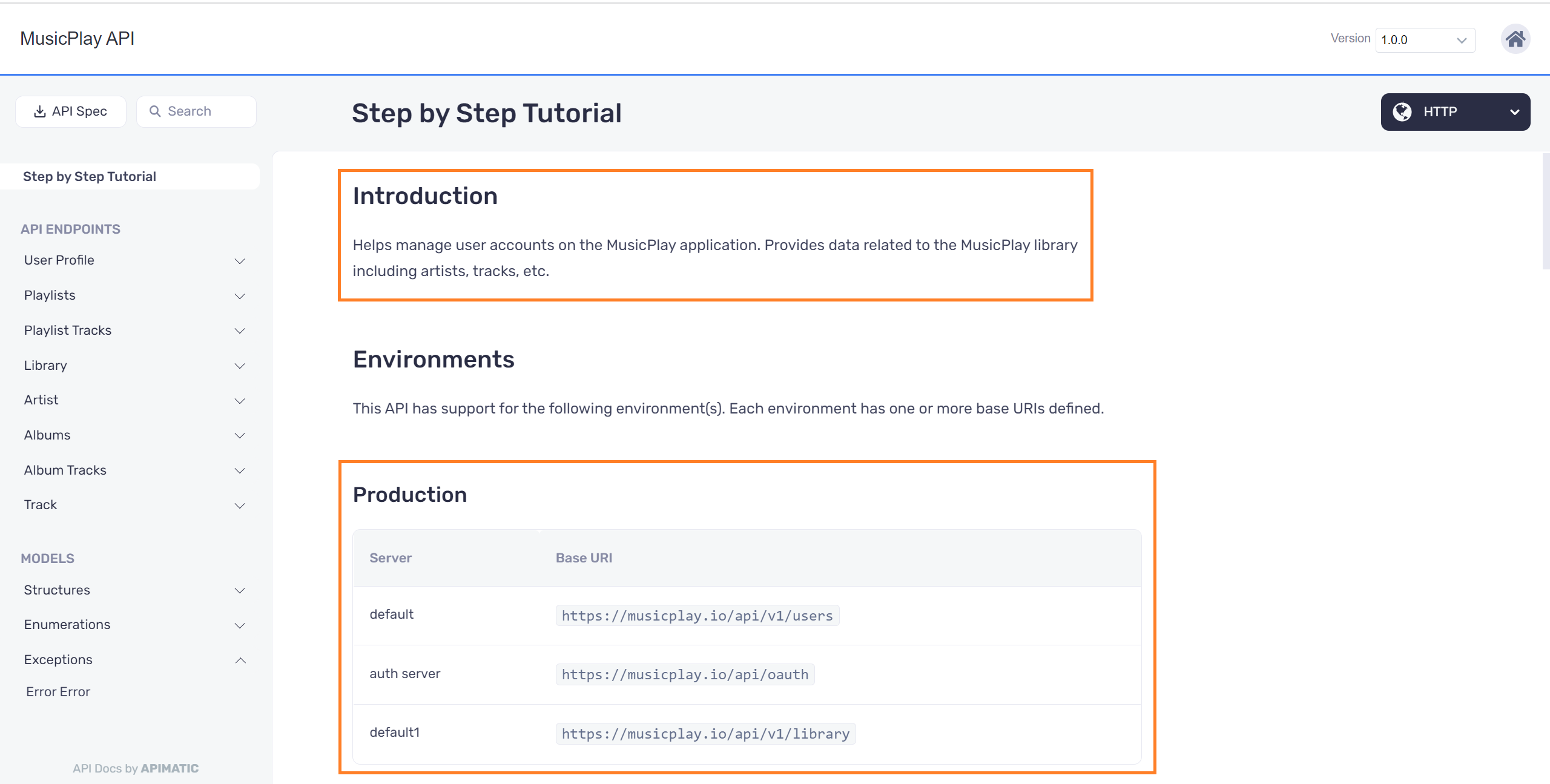
API Descriptions
As can be seen in the Introduction section, descriptions of both the User and Library APIs were combined because of the KeepBoth description conflict strategy configured earlier. Notice that the description from the User API has been added first as it was chosen to be the left API in the merge order.
API Servers
Production servers https://musicplay.io/api/v1/users and https://musicplay.io/api/v1/library from both APIs are added to the final server configuration.
API Authentication
MusicPlay User API authentication configuration:
components:
securitySchemes:
oauth2:
type: oauth2
flows:
authorizationCode:
authorizationUrl: https://musicplay.io/api/oauth/authorize
tokenUrl: https://musicplay.io/api/oauth/token
scopes:
write:user: modify user profile in your account
read:user: read user profile
write:playlist: modify user playlist
read:playlist: read user playlist
write:playlist-track: modify user playlist track
read:playlist-track: read user playlist trackMusicPlay Library API authentication configuration:
components:
securitySchemes:
oauth2:
type: oauth2
flows:
authorizationCode:
authorizationUrl: https://musicplay.io/api/oauth/authorize
tokenUrl: https://musicplay.io/api/oauth/token
scopes:
write:artist: modify artist profile
read:artist: read artist profile
write:album: modify artist album
read:album: read artist album
write:track: modify track details
read:track: read track detailsMerged output:
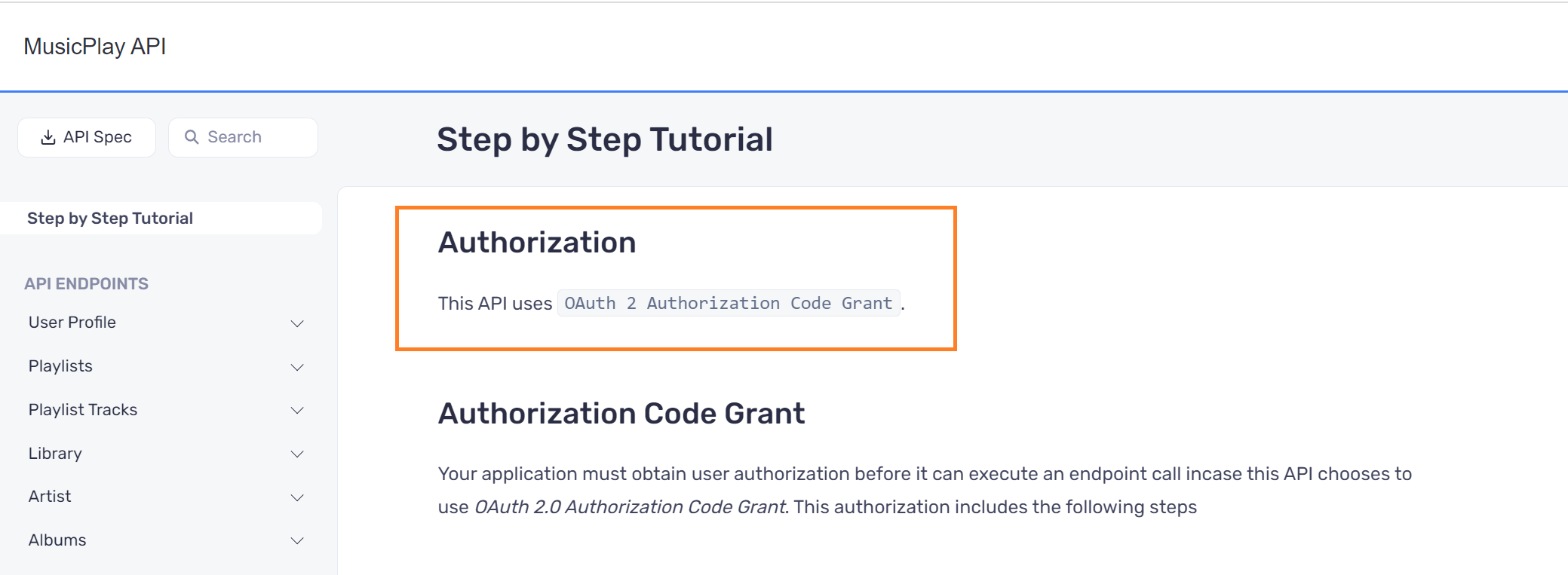
Since both APIs used the same OAuth 2 grant flow, the scopes of both APIs were merged together. Scopes from the left User API are shown first and then the scopes of the right Library API are shown: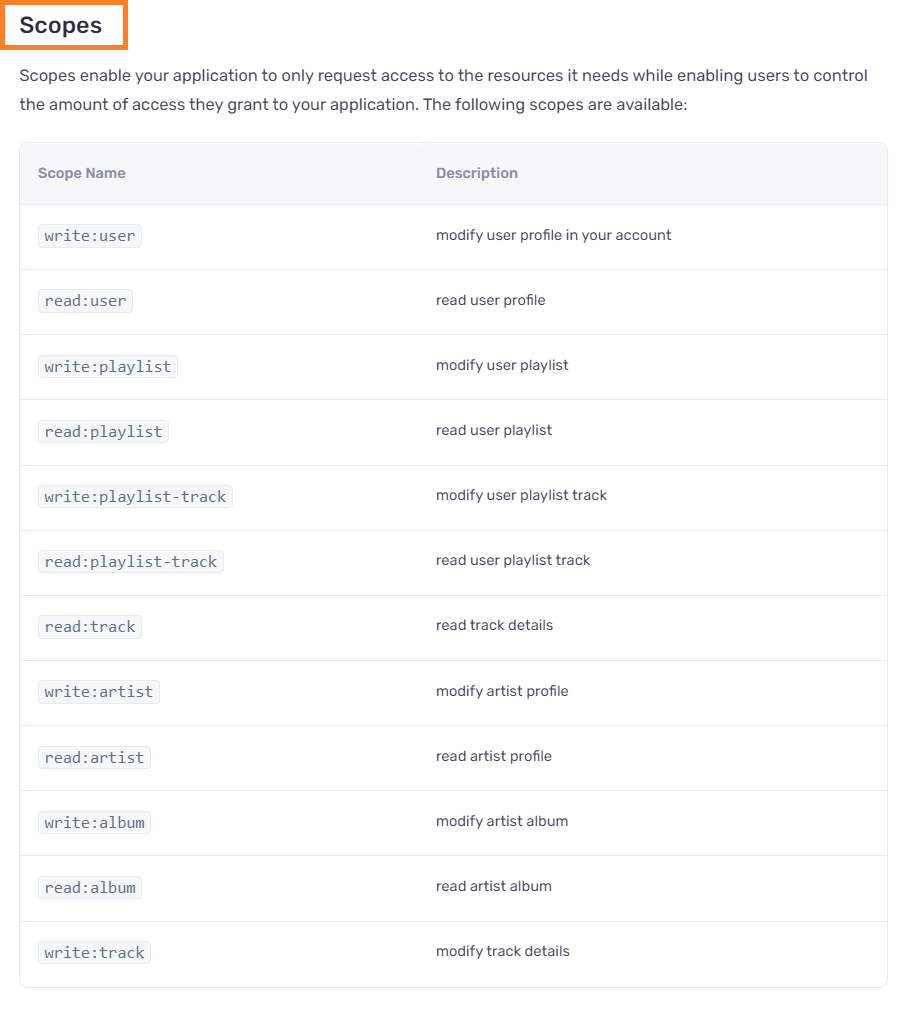
Models
MusicPlay User API model definitions (simplified):
components:
schemas:
UserProfile:
type: object
properties:
id:
type: string
name:
type: string
joined:
type: string
format: date-time
bio:
type: string
profilePictureUrl:
type: string
playlists:
type: array
items:
$ref: "#/components/schemas/UserPlaylist"
UserPlaylist:
type: object
properties:
id:
type: string
name:
type: string
description:
type: string
createdBy:
type: string
createdOn:
type: string
tracks:
type: array
items:
$ref: "#/components/schemas/UserPlaylistTrack"
isPublic:
type: boolean
UserPlaylistTrack:
type: object
properties:
id:
type: string
playlistId:
type: string
title:
type: string
addedBy:
type: string
addedOn:
type: string
format: date-time
track:
$ref: "#/components/schemas/Track"
Artist:
type: object
properties:
id:
type: string
name:
type: string
bio:
type: string
albums:
type: array
items:
$ref: "#/components/schemas/Album"
profilePictureUrl:
type: string
Album:
type: object
properties:
id:
type: string
name:
type: string
artistId:
type: string
createdOn:
type: string
format: date-time
tracks:
type: array
items:
$ref: "#/components/schemas/AlbumTrack"
AlbumTrack:
type: object
properties:
id:
type: string
albumId:
type: string
title:
type: string
addedBy:
type: string
addedOn:
type: string
format: date-time
track:
$ref: "#/components/schemas/Track"
Track:
type: object
properties:
id:
type: string
title:
type: string
duration:
type: number
format: int64
artist:
$ref: "#/components/schemas/Artist"
Error:
type: object
required:
- code
- message
properties:
code:
type: integer
format: int32
message:
type: stringMusicPlay Library API model definitions (simplified):
components:
schemas:
SearchResult:
type: object
properties:
title:
type: string
id:
type: string
type:
$ref: "#/components/schemas/LibraryComponentType"
album:
$ref: "#/components/schemas/Album"
artist:
$ref: "#/components/schemas/Artist"
track:
$ref: "#/components/schemas/Track"
LibraryComponentType:
type: string
enum:
- Artist
- Album
- Track
Artist:
type: object
properties:
id:
type: string
name:
type: string
bio:
type: string
albums:
type: array
items:
$ref: "#/components/schemas/Album"
profilePictureUrl:
type: string
Album:
type: object
properties:
id:
type: string
name:
type: string
artistId:
type: string
createdOn:
type: string
format: date-time
tracks:
type: array
items:
$ref: "#/components/schemas/AlbumTrack"
AlbumTrack:
type: object
properties:
id:
type: string
albumId:
type: string
title:
type: string
addedBy:
type: string
addedOn:
type: string
format: date-time
track:
$ref: "#/components/schemas/Track"
Track:
type: object
properties:
id:
type: string
title:
type: string
duration:
type: number
format: int64
artist:
$ref: "#/components/schemas/Artist"
Error:
type: object
required:
- code
- message
properties:
code:
type: integer
format: int32
message:
type: stringMerged output: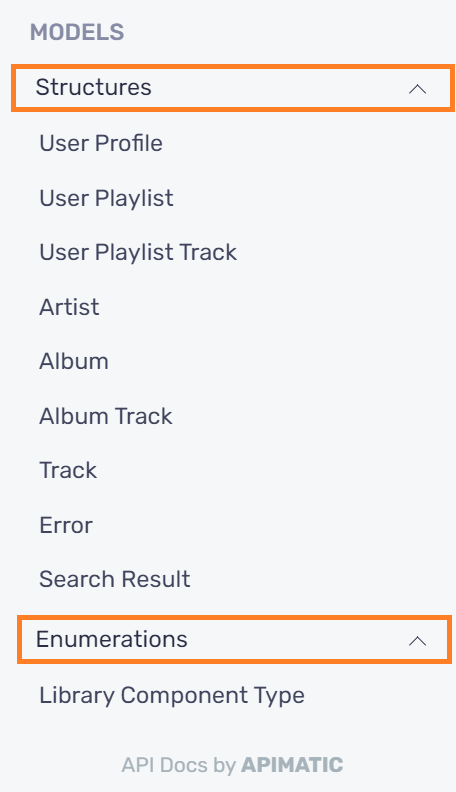
Overlapping models like Artist , Album, Track, etc. were not duplicated in the merged API definition. Just like with other components, models from the left User API are listed first and then the models from the Library API are shown.
API Endpoints
MusicPlay User API endpoints (simplified):
paths:
/:
get:
operationId: getAllUsers
security:
- oauth2: ["read:user"]
tags:
- users
- internal
responses:
'200':
description: User profile object.
content:
application/json:
schema:
type: array
items:
$ref: "#/components/schemas/UserProfile"
default:
description: Unexpected error.
content:
application/json:
schema:
$ref: "#/components/schemas/Error"
/{user-id}:
parameters:
- name: user-id
in: path
required: true
schema:
type: string
get:
operationId: getUserProfile
security:
- oauth2: ["read:user"]
tags:
- user profile
responses:
'200':
description: User profile object.
content:
application/json:
schema:
$ref: "#/components/schemas/UserProfile"
default:
description: Unexpected error.
content:
application/json:
schema:
$ref: "#/components/schemas/Error"
MusicPlay Library API endpoints (simplified):
paths:
/search:
get:
operationId: searchLibrary
parameters:
- name: searchQuery
in: query
required: true
schema:
type: string
- name: types
in: query
schema:
type: string
tags:
- library
responses:
'200':
description: Search results.
content:
application/json:
schema:
type: array
items:
$ref: "#/components/schemas/SearchResult"
default:
description: Unexpected error.
content:
application/json:
schema:
$ref: "#/components/schemas/Error"Merged output:
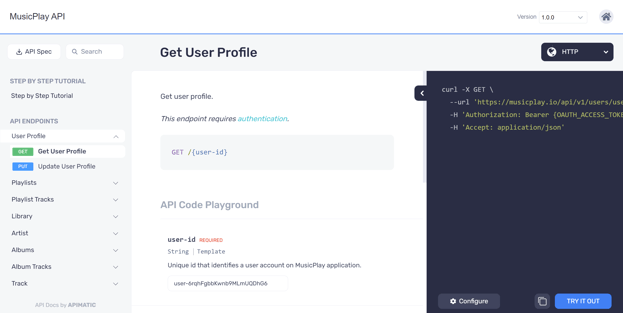
The endpoints are simply concatenated. Endpoint groups (or tags) from both APIs are listed in the API Endpoints section on the left. Endpoints from the User API are listed first since it was chosen to be the first API to be merged, in the merge order. Note also, that the tag internal is not part of the final tags/groups as it was filtered out during the merge process.
Useful Links
The full details of how merging works in APIMatic with sample walkthroughs and available configurations are documented here.
API descriptions for the two APIs “User API” and “Library API” (complete + simplified versions) as well as ready-to-merge directory structures for them can be found in my GitHub repo here.
Conclusion
To ease API integration and maximize API adoption rates, bring your services together under a single Developer Experience portal where your consumers will have direct access to language-specific documentation, live code samples, and SDKs per language. Reduce any manual efforts to get there by automatically merging specification documents that accompany your microservices.




